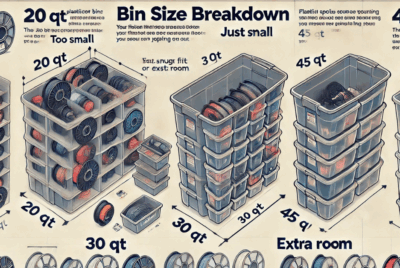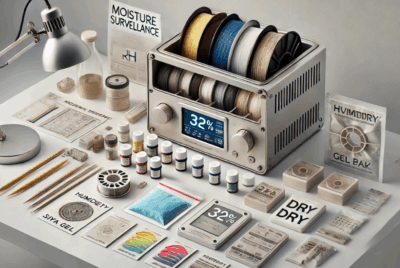What other methods protect filament from humidity?
Protecting filament from humidity is essential to ensure its quality and prevent issues like moisture absorption, which can negatively affect the printing process. There are several methods, beyond vacuum sealing and dry boxes, to protect filament from humidity. Here are some of the best alternatives:
1. Use of Silica Gel Packs
- How It Helps: Silica gel is a desiccant that absorbs moisture from the air, helping to keep the filament dry. It’s one of the most common methods used for moisture control.
- How to Do It: Place silica gel packets inside airtight containers or plastic bins with your filament spools. Ensure the silica gel is replaced or recharged regularly when it becomes saturated with moisture.
- Benefit: Affordable, easy to use, and effective for short- to medium-term storage.
2. Desiccant Containers
- How It Helps: Desiccant containers are specifically designed to absorb moisture from the air inside the container and prevent it from reaching the filament.
- How to Do It: Store filament in plastic containers or storage boxes with built-in desiccants. Some specialized filament storage containers come with compartments for moisture-absorbing packets, making them more effective.
- Benefit: Provides ongoing moisture control and is easy to incorporate into existing storage solutions.
3. Filament Dryers
- How It Helps: Filament dryers actively remove moisture from filament before printing, which is especially useful for moisture-sensitive filaments like Nylon, TPU, and ABS.
- How to Do It: Use a filament drying oven or filament dryer box, which typically heats the filament to a low, consistent temperature (usually around 40°C to 50°C) to drive out moisture.
- Benefit: Ideal for restoring moisture-laden filament to a printable state, and ensures high-quality prints even with previously wet filament.
4. Filament Spool Holders with Built-In Drying
- How It Helps: Some filament spool holders come with built-in desiccants or heating elements to maintain low humidity around the filament while it’s in use.
- How to Do It: Store your filament spools in spool holders that feature compartments for desiccants or built-in drying systems that can remove moisture as the filament is used.
- Benefit: These are great for active use, as they not only protect filament while it’s stored but also keep it dry during the printing process.
5. Humidity-Controlled Cabinets
- How It Helps: These cabinets use humidity controls to maintain an ideal environment for filament storage. Some models include built-in desiccants, while others regulate humidity using fans or dehumidifiers.
- How to Do It: Invest in a humidity-controlled storage cabinet that allows you to set a specific humidity level (usually between 20% and 40% relative humidity) to protect filament from moisture.
- Benefit: Provides consistent humidity control and is especially useful for long-term storage of high-value or moisture-sensitive filaments.
6. Plastic Bins with Airtight Seals
- How It Helps: Plastic bins with airtight seals can help protect filament from exposure to the outside air, which can carry moisture.
- How to Do It: Store filament in airtight plastic bins that are specifically designed to seal out air. You can also add desiccants inside the bin for extra moisture control.
- Benefit: Affordable and effective for general storage, especially when combined with desiccants or silica gel.
7. Store Filament in a Temperature-Controlled Room
- How It Helps: Humidity levels tend to fluctuate in areas with high temperatures or variable climates. Storing filament in a temperature-controlled room ensures that both temperature and humidity remain stable.
- How to Do It: Choose a cool, dry room to store your filament. Ideally, the temperature should be kept between 15°C and 25°C, with humidity levels below 60%.
- Benefit: Maintaining a stable environment helps prevent moisture absorption and reduces the risk of filament degradation over time.
8. Mylar Bags (Moisture-Resistant Bags)
- How It Helps: Mylar bags are highly effective at blocking moisture and air, making them a popular choice for storing filament. Mylar is a type of plastic film that is resistant to moisture and UV rays.
- How to Do It: Place filament spools in Mylar bags with desiccant packets. You can then vacuum seal the bags for added protection.
- Benefit: Excellent for long-term moisture protection and an affordable option for storing multiple filament rolls.
9. Use of Humidity Indicators
- How It Helps: Humidity indicators are small, color-changing strips that show the moisture levels inside a storage container. They allow you to monitor the effectiveness of your moisture control methods.
- How to Do It: Place a humidity indicator inside the storage container or dry box with your filament. This will let you know if the environment has become too humid, so you can take corrective action.
- Benefit: Provides real-time monitoring of your filament storage conditions, ensuring that your filament stays dry and protected.
10. Desiccant Beads or Packs in Storage Bags
- How It Helps: Desiccant beads or packs are small, reusable packets that absorb moisture and help prevent humidity from affecting the filament. They are often placed inside airtight bags, boxes, or containers.
- How to Do It: Place desiccant beads or packs inside storage bags or airtight containers where you store filament. Some filament storage solutions come with built-in desiccant compartments.
- Benefit: Low-cost and easy-to-use method for ensuring dry filament storage.
Summary of Methods to Protect Filament from Humidity:
- Airtight Containers: Use sealed containers to prevent moisture exposure and add desiccants for extra protection.
- Filament Dry Box: Actively controls humidity, ensuring filament stays dry during use and storage.
- Vacuum Sealing: Removes air and moisture by sealing filament in bags with desiccants.
- Desiccant Containers: Store filament with desiccants to keep moisture levels low.
- Spool Holders with Drying Features: Keeps filament dry during use, often with desiccants or heaters.
- Humidity-Controlled Cabinets: Use these cabinets to store filament in a controlled, low-humidity environment.
- Plastic Bins with Airtight Seals: Use airtight bins combined with desiccants for moisture control.
- Temperature-Controlled Rooms: Store filament in a stable, cool, and dry room to maintain optimal conditions.
- Mylar Bags: Store filament in moisture-resistant bags with desiccants for long-term protection.
- Humidity Indicators: Monitor moisture levels inside storage containers to ensure proper conditions.
By using one or more of these methods, you can significantly reduce the risk of filament degradation caused by moisture, extending the lifespan of your filament and ensuring high-quality prints.




